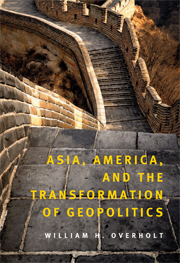Book contents
- Frontmatter
- Contents
- Figures
- Tables
- Preface
- Acknowledgments
- Overview
- CHAPTER ONE Introduction: The Inertia of Foreign Policies
- CHAPTER TWO Cold War Assumptions and Changing Realities
- CHAPTER THREE Regional Trends
- CHAPTER FOUR Asia's Big Powers: Japan and China
- CHAPTER FIVE Smaller Places, Decisive Pivots: Taiwan, Korea, Southeast Asia
- CHAPTER SIX The Aspiring Power and Its Near Abroad: India and South Asia
- CHAPTER SEVEN Russia and Its Near Abroad
- CHAPTER EIGHT The United States and the New Asia
- CHAPTER NINE Scenarios for the Future
- CHAPTER TEN Conclusion
- Bibliography
- Index
CHAPTER FIVE - Smaller Places, Decisive Pivots: Taiwan, Korea, Southeast Asia
Published online by Cambridge University Press: 05 September 2012
- Frontmatter
- Contents
- Figures
- Tables
- Preface
- Acknowledgments
- Overview
- CHAPTER ONE Introduction: The Inertia of Foreign Policies
- CHAPTER TWO Cold War Assumptions and Changing Realities
- CHAPTER THREE Regional Trends
- CHAPTER FOUR Asia's Big Powers: Japan and China
- CHAPTER FIVE Smaller Places, Decisive Pivots: Taiwan, Korea, Southeast Asia
- CHAPTER SIX The Aspiring Power and Its Near Abroad: India and South Asia
- CHAPTER SEVEN Russia and Its Near Abroad
- CHAPTER EIGHT The United States and the New Asia
- CHAPTER NINE Scenarios for the Future
- CHAPTER TEN Conclusion
- Bibliography
- Index
Summary
Taiwan
Striving for negotiations, preparing for war, not fearing delays.
—Chinese President Hu Jintao's summary of China's Taiwan strategyBig-power maneuvering over the status of Taiwan is absolutely crucial to Asia's future geopolitics, so this discussion pays particularly detailed attention to Taiwan.
The island of Taiwan lies 90 miles off the coast of China. Most of its population migrated over a long period of time from the mainland of China, and the majority speak a version of the dialect of Fujian Province. The Dutch occupied Taiwan from 1624 to 1662. At the end of that period, the Ming Dynasty was collapsing, and its last remnant, led by Koxinga, or Cheng Cheng-kung, fled to Taiwan and captured it. In 1683, the new Qing Dynasty defeated Koxinga and conquered the island. Subsequently the Qing Dynasty treated Taiwan as a prefecture of Fujian Province, but because of difficult communications and transportation, Qing rule was loose. Dissidence was frequent.
In 1895, Japan forced China to cede Taiwan in perpetuity as part of the settlement of the Sino-Japanese War. This was the first colonial thrust of Japanese empire, followed by the conquest of Korea in 1905, the Twenty-One Demands on China in 1915, and later by the full invasion of China and Southeast Asia and the attack on Pearl Harbor. Japanese rule ended in 1945 with Japan's defeat in World War II.
Like other colonies, Taiwan was returned to its original master, and the original master was assumed to be China. At the Cairo Conference in 1943, the allies agreed that Taiwan should be returned to China as represented then by Chiang Kai-shek's Guomindang Party. China subsequently descended into full civil war.
- Type
- Chapter
- Information
- Asia, America, and the Transformation of Geopolitics , pp. 139 - 186Publisher: Cambridge University PressPrint publication year: 2007

